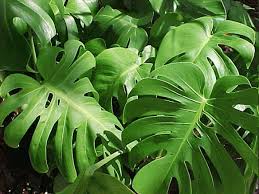If you crave a touch of the rainforest in your home, the Monstera deliciosa, with its dramatically split leaves, is the plant for you! While sometimes affectionately called the “split-leaf philodendron,” this stunning beauty belongs to the Monstera genus. Let’s explore how to provide the ideal environment for it to flourish and reach its full, split-leaf potential.

The Basics for Thriving Growth
- Light: The Goldilocks Zone for Leaves Your Monstera craves ample light but not the harsh, direct kind. Imagine the dappled sunlight it would receive in its natural rainforest home and try to emulate that. An east-facing window or a spot with filtered light is perfect. Too much direct sun will scorch those beautiful leaves, while too little will limit growth and those iconic splits.
- Watering: Let the Soil Guide You Your Monstera likes a little dryness between drinks. Wait until the top few inches of soil feel dry to the touch before giving it a thorough watering. Remember, it’s easier to recover from slight underwatering than to deal with the issues overwatering can cause.
- Humidity: A Touch of the Tropics While more forgiving than some of its Monstera cousins, your deliciosa will still appreciate a bit of extra moisture. If you notice crispy leaf edges or slower growth, try a humidifier, placing it on a pebble tray, or grouping it with other humidity-loving plants.
- Soil: Airy and Well-Draining Think loose and chunky, like the forest floor. Aroid potting mixes offer perfect drainage. You can even make your own blend with ingredients like coco coir, perlite, and a touch of potting soil for a nutritional boost.
Unlocking Optimal Growth
- Upward and Onward: Mimic its Natural Habitat Monstera deliciosa plants are natural climbers. Provide a moss pole or trellis to encourage healthy growth. This leads to those stunning, mature leaves with their characteristic deep splits!
- Nourishment for Growth During spring and summer, give your Monstera a little boost with a diluted, balanced liquid fertilizer every few weeks. Follow the instructions for the best results, and remember, a little goes a long way.
- Ideal Temperature: Tropical Warmth This plant prefers a cozy range between 60-80°F. Protect it from chilly drafts, especially in winter, as they can cause stress and damage.
The “Split-Leaf Philodendron” Mystery
You may have heard the Monstera deliciosa called a “split-leaf philodendron.” This nickname comes from the plant’s botanical history. It was once classified under the Philodendron genus, but that’s been updated! While both Monsteras and Philodendrons are in the Araceae family, they boast unique characteristics.
Troubleshooting Common Issues
- Yellowing Leaves: What’s Going On? This usually points to a watering issue – either overwatering or underwatering. Check the soil moisture, adjust your watering habits, and make sure your plant has good drainage.
- Why No Splits? Monsteras develop their iconic fenestrations (splits and holes) as they mature, particularly on climbing plants. Give your plant something to climb on and ensure it’s getting enough bright, indirect light.
- Pesky Pests Like many houseplants, Monsteras might attract spider mites, scale, or mealybugs. Keep a close eye out and address any infestations quickly with natural methods.
Propagating Your Monstera: Share the Love
Sharing the Monstera deliciosa love is easy! Here’s how:
- Find a Node: These are the little brown bumps on the stem, usually where a leaf or aerial root joins.
- Snip and Propagate: Cut a stem section with a node and at least one leaf. Try water propagation (submerge the node in a jar of water) or plant it directly in moist, well-draining soil.
- Light and Patience: Give your cutting bright, indirect light and wait patiently. Roots should appear within a few weeks.
Conclusion With a little care, your Monstera deliciosa (or should we say, your “split-leaf philodendron”😉) will become a statement piece in your home. Imagine those lush, split leaves cascading or climbing up a support – a living embodiment of rainforest magic!
Leave a Reply